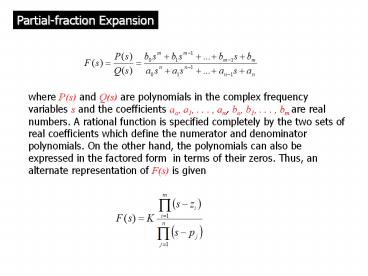Partial-fraction Expansion - PowerPoint PPT Presentation
Title:
Partial-fraction Expansion
Description:
Partial-fraction Expansion where P(s) and Q(s) are polynomials in the complex frequency variables s and the coefficients ao, a1, . . . , an, bo, b1, . . . , bm are ... – PowerPoint PPT presentation
Number of Views:290
Avg rating:3.0/5.0
Title: Partial-fraction Expansion
1
Partial-fraction Expansion
where P(s) and Q(s) are polynomials in the
complex frequency variables s and the
coefficients ao, a1, . . . , an, bo, b1, . . . ,
bm are real numbers. A rational function is
specified completely by the two sets of real
coefficients which define the numerator and
denominator polynomials. On the other hand, the
polynomials can also be expressed in the factored
form in terms of their zeros. Thus, an alternate
representation of F(s) is given
2
The first step in the partial-fraction expansion
is to put the rational function into a proper
form. We say that a rational function is proper
if the degree of the numerator polynomial is less
than the degree of the denominator polynomial. If
the given rational function F(s) is not proper,
i.e.., if the degree of P(s) is greater than or
equal to that of Q(s), we divide (long division)
P(s) by Q(s) and obtain
The quotient, is a polynomial and R(s) is the
remainder therefore, R(s) has a degree less than
that of Q(s), and the new rational function
R(s)/Q(s) is proper. Since is a polynomial,
the corresponding time function is a linear
combination of ?,?(1),?(2), etc., and can be
determined directly using Tables. We therefore go
ahead with the new rational function R(s)/Q(s)
which is proper. In the remaining part of this
section we assume that all rational functions are
proper.
3
Second Order Polynomial
- Roots of Q(s) are called poles and roots of P(s)
are called zeros. (polt in the complex frequency
domain zeros as o and poles as x) - In general we may write a second order Q(s) as
- The roots are
- If the damping ratio gt1 (roots are real distinc
simple) - If the damping ratio lt1 (roots are complex
conjugates - If the damping ratio 1 (roots are real equal
repeated)
4
Case 1 Simple poles
We start with a simple example as follows
We claim that there are constants K1, K2, and K3
such that
Heavisides Expansion
Compare Heavisides Expansion with solving for K
or substituting convenient values for s.
5
and the residue Kj of the pole pj is given by
6
Case 2 Multiple poles
Find the partial-fraction expansion of
The function has two multiple poles at s p1-1
(third order, n13) and at s p2 0 (second
order,n2 2). Thus, the partial fraction
expansion is of the form
To calculate K11, K12, and K13, we first multiply
F(s) by (s 1)3 to obtain
Using (5-115) we find
7
Similarly, to calculate K21 and K22, we first
multiply F(s) by s2 to obtain
Using (5-115), we find
Therefore, the partial-fraction expansion is
The corresponding time function is
8
Case 3 Complex poles
The two cases presented above are valid for poles
which are either real or complex. However, if
complex poles are present, the coefficients in
the partial-fraction expansion are, in general,
complex, and further simplification is possible.
Using formula for simple poles, we obtain
9
Since F(s) is a rational function of s with real
coefficients, it follows that K2 is the complex
conjugate of K1. Once K and K are determined,
the corresponding two complex terms can be
combined as follows Suppose Kajb. Then
Ka-jb, and
Once, we find a and b, given, , using
the Inverse Laplace transform, we get
10
This formula, which gives the corresponding time
function for a pair of terms due to the complex
conjugate poles, is extremely useful.
There are good Matlab examples in your text book
utilizing the command residue
Practice the examples































